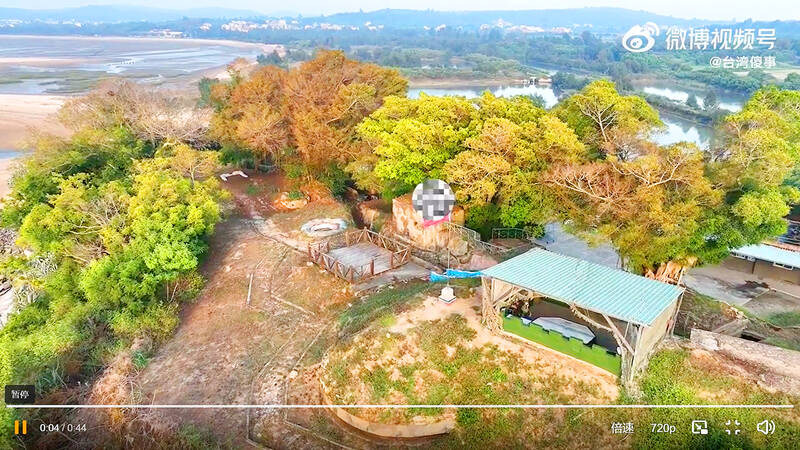The Kinmen Defense Command yesterday said it would drive Chinese drones out of Kinmen County, and shoot them down if warnings are ignored.
The command made the announcement after video footage taken from a drone that circled above troops stationed in the county’s Lieyu Township (烈嶼) circulated on Chinese microblogging site Sina Weibo (微博) on Saturday.
Troops had noticed the drone over the township on Saturday, and had determined it to be a civilian drone, the command said in a news release.

Photo: Still image taken from a video on Sina Weibo
In accordance with standard procedure, the troops fired a warning flare at the drone and went on high alert, it said.
The military aims to avoid escalating such situations, but would take countermeasures to prevent incursions into the country’s airspace by drones and other airborne objects, the command said, adding that China has been making such incursions with increasing regularity over the past few weeks.
“These repeated provocations are a threat to Taiwan’s national defense and aviation safety, and we will take necessary measures to stop them,” the command said.
On Aug. 16, a separate video circulated on Sina Weibo showing Taiwanese troops throwing stones at a Chinese drone that entered airspace above Erdan Islet (二膽).
The incident was criticized by the Ministry of National Defense as a Chinese attempt at cognitive warfare and sparked public debate about how the military should respond to “gray-zone” tactics — defined as coercive actions carried out by seemingly non-state or nonmilitary actors.
The ministry on Wednesday last week said it had already drafted plans for a drone defense system, which it expects to deploy next year.
GEOSAT Aerospace & Technology Inc (經緯航太科技) chief executive officer Lo Cheng-fang (羅正方) yesterday said that the army should not hesitate to use counter-drone weapons if any are spotted in Taiwan’s territorial airspace.
When faced by China’s provocative gray-zone tactics, the worst thing Taiwan can do is nothing, because it would simply encourage Beijing to be more aggressive, he said.
Lu Li-shih (呂禮詩), a former navy lieutenant commander, said that the army should try to set up a virtual perimeter known as a geofence around a no-fly zone between the offshore counties and China to stop drones from entering.
Democratic Progressive Party Legislator Wang Ting-yu (王定宇) said that the ministry could work with domestic drone manufacturers to devise drone-defense solutions.
Speaking about an incident yesterday in which two Chinese fishers washed up alive in the county, Wang said that authorities should provide all necessary assistance in such cases, but exercise caution and thoroughly investigate whether other motives are at play.

The US government has signed defense cooperation agreements with Japan and the Philippines to boost the deterrence capabilities of countries in the first island chain, a report by the National Security Bureau (NSB) showed. The main countries on the first island chain include the two nations and Taiwan. The bureau is to present the report at a meeting of the legislature’s Foreign Affairs and National Defense Committee tomorrow. The US military has deployed Typhon missile systems to Japan’s Yamaguchi Prefecture and Zambales province in the Philippines during their joint military exercises. It has also installed NMESIS anti-ship systems in Japan’s Okinawa

‘WIN-WIN’: The Philippines, and central and eastern European countries are important potential drone cooperation partners, Minister of Foreign Affairs Lin Chia-lung said Minister of Foreign Affairs Lin Chia-lung (林佳龍) in an interview published yesterday confirmed that there are joint ventures between Taiwan and Poland in the drone industry. Lin made the remark in an exclusive interview with the Chinese-language Liberty Times (the Taipei Times’ sister paper). The government-backed Taiwan Excellence Drone International Business Opportunities Alliance and the Polish Chamber of Unmanned Systems on Wednesday last week signed a memorandum of understanding in Poland to develop a “non-China” supply chain for drones and work together on key technologies. Asked if Taiwan prioritized Poland among central and eastern European countries in drone collaboration, Lin

Renewed border fighting between Thailand and Cambodia showed no signs of abating yesterday, leaving hundreds of thousands of displaced people in both countries living in strained conditions as more flooded into temporary shelters. Reporters on the Thai side of the border heard sounds of outgoing, indirect fire yesterday. About 400,000 people have been evacuated from affected areas in Thailand and about 700 schools closed while fighting was ongoing in four border provinces, said Thai Rear Admiral Surasant Kongsiri, a spokesman for the military. Cambodia evacuated more than 127,000 villagers and closed hundreds of schools, the Thai Ministry of Defense said. Thailand’s military announced that

CABINET APPROVAL: People seeking assisted reproduction must be assessed to determine whether they would be adequate parents, the planned changes say Proposed amendments to the Assisted Reproduction Act (人工生殖法) advanced yesterday by the Executive Yuan would grant married lesbian couples and single women access to legal assisted reproductive services. The proposed revisions are “based on the fundamental principle of respecting women’s reproductive autonomy,” Cabinet spokesperson Michelle Lee (李慧芝) quoted Vice Premier Cheng Li-chiun (鄭麗君), who presided over a Cabinet meeting earlier yesterday, as saying at the briefing. The draft amendment would be submitted to the legislature for review. The Ministry of Health and Welfare, which proposed the amendments, said that experts on children’s rights, gender equality, law and medicine attended cross-disciplinary meetings, adding that